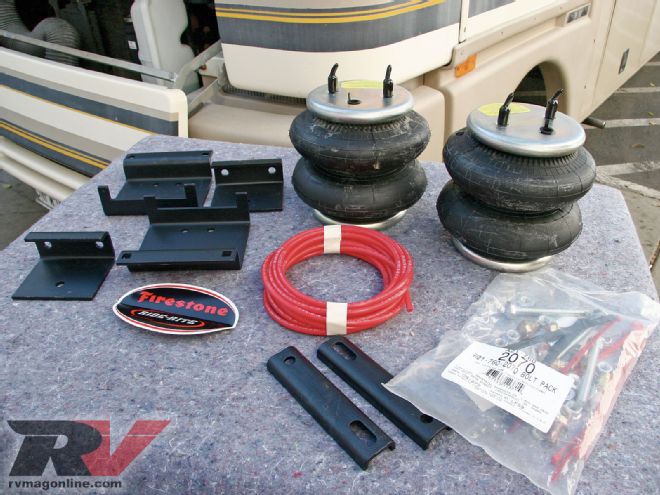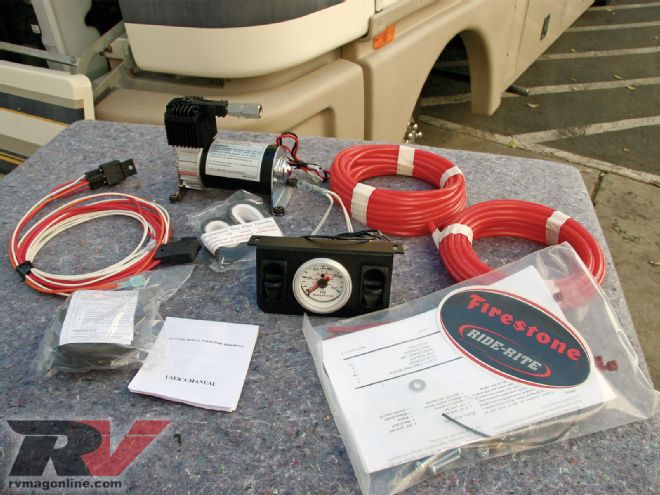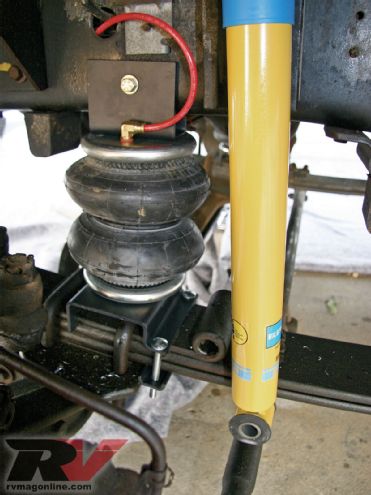Time has a way of making everything sag, droop, and fall. Just ask anyone over the age of 40. Believe it or not, the suspension of an early-model RV, truck, or van is no different. Eventually it's going to fail to a point that the ride and handling are sloppy and extreme loads are a real safety issue.

| Before we installed the Firestone Ride-Rite Air Helper Springs, this Bounder had lost its road manners and load capacity. The installation gained more clearance, and the Bounder handled like a newer RV once again.
That's why for the automotive market, airbag technology has proven to be such an effective upgrade. There are many reliable products that feature airbag technology, but the first to create the concept and put it to use was Firestone during the 1930s.
As we learned, Firestone's Ride-Rite Air Helper Springs can be installed on most light trucks, motorhomes, RVs, SUVs, and vans relatively easily. The "helper springs" shown in this story were not a replacement for your factory suspension parts; the Firestone kit was mounted between the frame of the vehicle and the suspension, providing proven load support using air pressure.
For our installation on a '95 Fleetwood Bounder F-53 chassis, we used Firestone's double-convoluted Air Helper springs, which can be adjusted for changing loads. This kit is capable of 3,200 to 5,000 pounds of load leveling per set. That's not to suggest that you will be able to exceed the factory GVWR (gross vehicle weight rating) by 3,200 to 5,000 pounds. It means the Air Helper Springs enhance the ride by reducing leaf friction and will handle 3,200 to 5,000 pounds of weight. Your manufacturer's GVWR remains unchanged, and it would be a mistake to exceed it.
What the helper springs do is keep vehicles level, which improves steering control and braking. A leveled vehicle also means less tire wear. The Ride-Rite Air Helper Springs are great with off-center loads, and the kit allows for adjustments side-to-side, or in our case back-to-back. Firestone also makes a kit that lets you adjust the level of all four corners independently if you want to customize your load capability.
In a nutshell, airbag technology does improve the ride and can absorb much of the load, which reduces bottoming out and offers a protective air cushion that softens contact between the axle and frame.
The basic kit we installed included heavy-duty mounting brackets, dual-bellows Firestone-made airbags, hardware, an owner's manual, and air lines with special valves. An optional Air Control Accessory Kit allowed us to inflate and deflate the airbags from inside the cab.
It's good to know that some airbag kits for the RV, truck, and van market install at the leaf or axle, while others go inside the coil spring, depending on the application. Airbags are either triple-, double- or single-bellow in general, and the size of the bag relates to its load capacity.
We installed the Ride-Rite system on this early model Class-A for two primary reasons: Its factory mechanical springs had lost some of their load rating, and the rear of the motorhome had fallen an inch or two below stock. Some new RV manufacturers are using similar airbag systems on newer motorhomes, trucks, and vans, so we knew this technology would work.

| We located the Firestone air compressor kit near the grille for easy access, and so it would be out of the elements. The air compressor filled the airbags up the maximum 100 psi in less than a minute.
"The airbag is essentially a spring filled with air," says Justin Sagert of Pickup Parts in Mission Viejo, California. "We see a lot of customers that buy used motorhomes or heavy-duty trucks that have lost some suspension capacity from years of use. The airbag is the perfect upgrade for the person who wants to recover a street-quality ride and excellent load carrying capabilities."
What's more, airbags allow you to increase or decrease the pressure inside the bag, something that you can't do with mechanical springs. That helps distribute loads for the best possible outcome.
Once the folks at Pickup Parts completed the job, the Bounder's ride improved immediately, especially in cornering, where once it had oscillated and swayed. We also gained 3 more inches of clearance at all four corners.
The kit from Firestone for the Class 3 Bounder retails for just over $1,000, not including the Air Control Accessory Kit, but we think it was an investment that added years of life to this classic Class A from Fleetwood.


